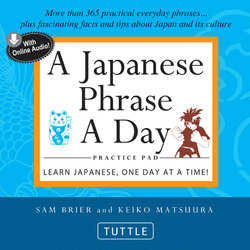Читать книгу Japanese Phrase A Day Practice Pad - Sam Brier - Страница 7
ОглавлениеPronunciation
Japanese is easily pronounced by native English speakers, and unlike many Asian languages, Japanese does not have tones. The grammar and characters are the most challenging, and because of this, phrases in this pad are kept short, simple and functional. Plus, you can listen to the audio files for each phrase repeatedly online.
All sounds in Japanese are easily pronounced in English and are almost identical to the way they are pronounced in Spanish.
Below are charts of the two Japanese alphabets: hiragana and katakana. (Together these two alphabets are termed kana.) The former is used to write Japanese words, and the latter is used to write foreign words. Also used to write Japanese are kanji, characters derived from Chinese.
The small hiragana that you will see written over the Japanese characters derived from (and often identical to) Chinese are called furigana. They show you the pronunciation of the kanji below. Furigana are useful guides, but they are only used in text that’s meant for education purposes, like this phrase-a-day pad. Furigana isn’t seen in typical situations.
Keep in mind that all Japanese consonants are followed by a vowel (for example, Ka, Ki, Ku, Ke, Ko). The letter N is the only exception. N can be followed by a vowel, can be repeated in the middle of a word, and it can end a word.
Also, note the short line that is on top of some vowels from time to time. This means that the vowel is long (that is, the sound is held twice as long when you say it); otherwise it is short.
VOWEL SOUNDS
A sounds like the a in ah
AI sounds like the y in by あい / アイ
I sounds like the e in be
U sounds like the oo in boo
E sounds like the e in best
EI is a long A sound, like the ay in day えい / エイ
O sounds like the o in open
